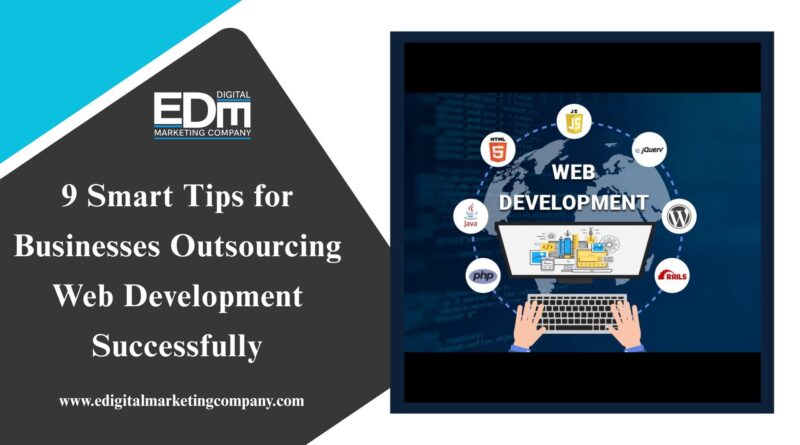9 Smart Tips for Businesses Outsourcing Web Development Successfully
In today’s digital-first world, every business needs a strong online presence to remain competitive. Web development, however, is not just about creating a website-it’s about building a platform that represents your brand, engages customers, and drives revenue. Many companies struggle with limited budgets, lack of skilled developers, or time constraints, which is why outsourcing web development has become a smart and effective solution. Done correctly, outsourcing can provide cost efficiency, access to global talent, and faster delivery without compromising quality. Here are nine smart tips businesses should follow to outsource web development successfully.
What is Web Development?
Web development is the process of creating, building, and maintaining websites or web applications that run on the internet. It goes far beyond simple design-it combines technical programming, coding, and user interface elements to deliver a fully functional online experience. At its core, web development covers three main areas: front-end development (what users see and interact with), back-end development (the server-side logic, databases, and APIs that power the site), and full-stack development (a combination of both).
Modern web development also includes security enhancements, responsive design for mobile devices, performance optimization, and integration with tools such as payment gateways or content management systems. For businesses, web development is not just about having an online presence-it’s about creating a platform that strengthens branding, improves customer engagement, and drives revenue growth.
-
Define Clear Goals and Requirements
Before you begin outsourcing, you must clearly define your goals, technical requirements, and project scope. Whether it’s an eCommerce store, a SaaS product, or a corporate website, having a well-documented plan avoids confusion later. List out expected features, design preferences, technology stack, and timeline. This helps outsourcing partners understand exactly what you need and ensures your vision is accurately executed. A lack of clarity is the number one reason for outsourcing failures, so this step is non-negotiable.
-
Choose the Right Outsourcing Model
There are several outsourcing models: onshore, nearshore, and offshore. Each comes with benefits and trade-offs. Onshore guarantees cultural alignment and easy communication but may be costlier. Nearshore offers a balance of affordability and collaboration. Offshore provides access to a vast global talent pool at competitive prices but requires strong communication management. Selecting the right model based on your project complexity, budget, and time zone preferences ensures long-term success.
-
Evaluate Portfolios and Case Studies
Never hire an outsourcing partner blindly. Check their portfolio, case studies, and past client testimonials to measure their expertise. Look for projects similar to yours in size, industry, or technology stack. A strong track record in delivering scalable and secure websites is a green flag. Additionally, request sample work or code snippets to evaluate quality standards. Doing your due diligence upfront minimizes risks and increases your chances of working with a reliable partner.
-
Prioritize Communication and Transparency
Smooth communication is the foundation of a successful outsourcing relationship. Ensure your partner uses collaboration tools like Slack, Jira, or Trello for regular updates. Set expectations on weekly calls, progress reports, and response times. Transparency in reporting, timelines, and billing avoids misunderstandings. Remember, outsourcing doesn’t mean losing control-it’s about building a collaborative relationship where both sides share responsibility.
-
Focus on Data Security and Intellectual Property
When outsourcing web development, your business data and intellectual property are valuable assets that must be protected. Always sign NDAs (Non-Disclosure Agreements) and clearly define ownership of the final code, designs, and deliverables in the contract. Ask about your partner’s security policies, data encryption practices, and compliance with GDPR or other relevant regulations. Secure collaboration protects your business reputation and prevents costly disputes later.
-
Establish Realistic Budgets and Timelines
While outsourcing often reduces costs, the cheapest option is not always the best. Set a realistic budget that balances quality and affordability. Discuss hourly rates versus fixed-cost projects and understand what’s included in the price. Likewise, break your project into milestones with achievable deadlines. Milestone-based payments ensure accountability and give you control over progress without overspending. Proper planning here saves time, money, and frustration.
-
Start Small Before Scaling
Instead of handing over an entire project immediately, start with a smaller deliverable or pilot project. This allows you to test your partner’s capabilities, communication, and quality of work. Once you are satisfied, you can gradually scale to larger, more complex tasks. Starting small reduces risk and builds trust while ensuring the outsourcing partner truly understands your business needs.
-
Ensure Post-Development Support
A successful outsourcing partnership doesn’t end at project delivery. Websites require ongoing maintenance, updates, security patches, and performance optimizations. Ensure your outsourcing contract includes post-launch support, training, and documentation. Many businesses overlook this and face issues later when bugs arise or new features are needed. A partner who provides long-term support proves to be a valuable extension of your team.
-
Build a Long-Term Partnership, Not a Transaction
Outsourcing works best when viewed as a long-term partnership rather than a one-time transaction. Invest time in understanding your partner’s strengths, culture, and way of working. A trusted outsourcing partner will learn your business goals, innovate solutions, and help you scale faster. Businesses that treat outsourcing as a strategic collaboration achieve better results than those who only focus on cost savings.
Final Thoughts: Why Partner with Us?
Outsourcing web development can transform your business if done strategically. By following these nine tips, you’ll minimize risks, save costs, and gain access to world-class talent that can bring your vision to life. At eDigitalMarketingCompany.com, we specialize in providing custom web development outsourcing services tailored to global businesses. From SaaS platforms and MVP development to eCommerce and corporate websites, our team delivers scalable, secure, and high-performing solutions. With transparent communication, robust security, and ongoing support, we ensure your projects are completed successfully-on time and within budget.
Ready to take your business to the next level? Outsource your web development services with us today and experience the difference.

